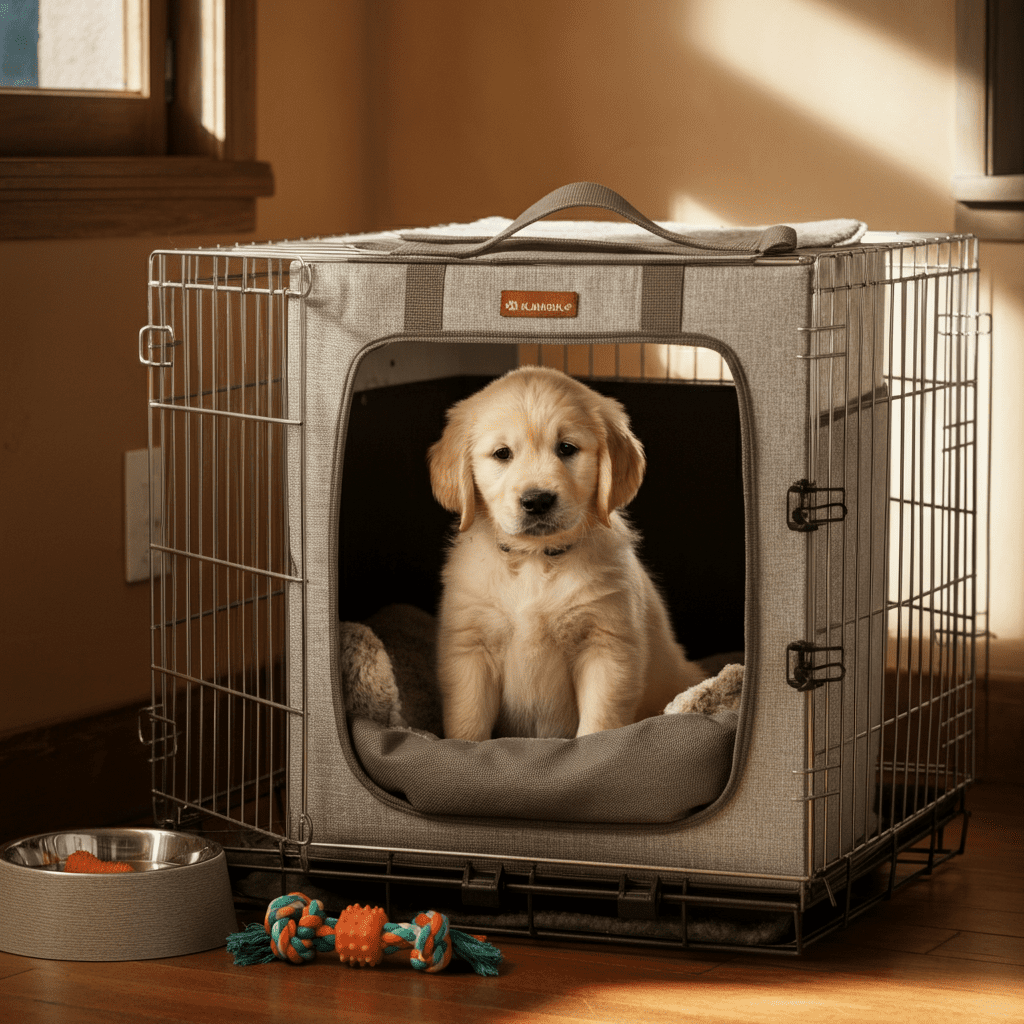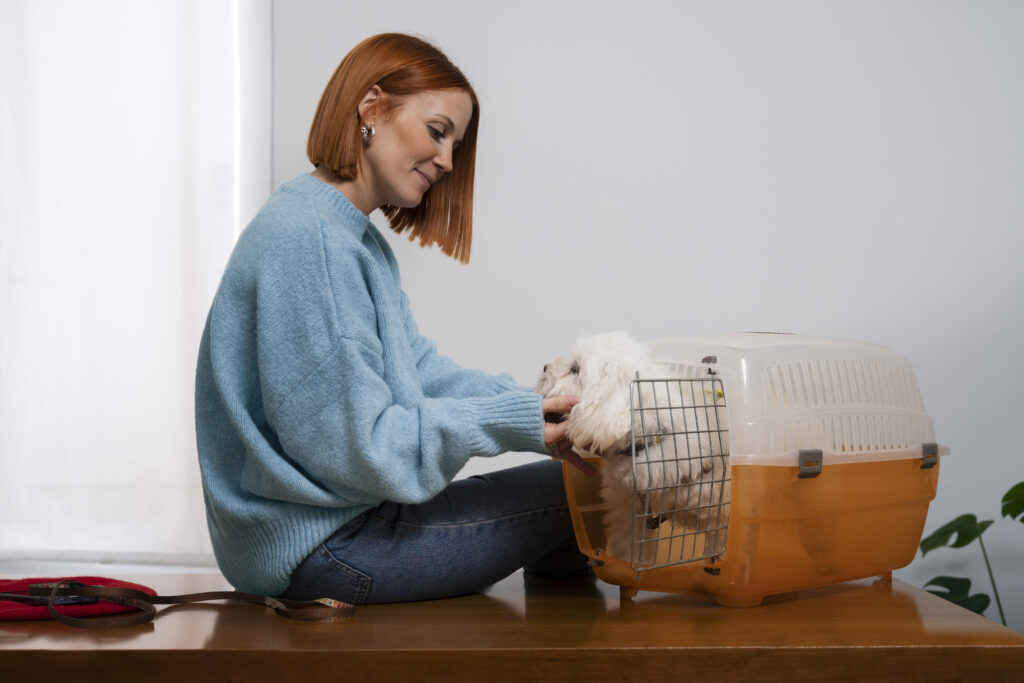
Crates can be one of the most valuable tools for dog owners, offering a safe and secure space for your furry friend while helping with training and behavior management. However, knowing how long a dog can be in a crate is just as crucial as knowing how to crate train them effectively. When used correctly, crating ensures your dog’s safety and well-being while easing stress for their human companions.
This guide will explore general crate time guidelines, factors influencing crate duration, and how to create a safe and comfortable crate environment. You’ll also find answers to the most common crate-related questions to ensure your dog—or new puppy—feels at home in their crate.”
Let me know if you need any further adjustments!
General Crate Time Guidelines
Crate training is gradual, and understanding how long your dog can safely stay in a crate is crucial. While crate times vary depending on your dog’s age, breed, and individual needs, here are some essential guidelines to follow:
The Puppy Rule
A good rule of thumb for puppies is age in months + 1 hour. For example, a 3-month-old puppy should not be crated for more than 4 hours. Puppies have small bladders and high energy levels, so frequent potty breaks, attention, and playtime are essential.
Adult Dogs
Most adult dogs can tolerate crating for up to 8-9 hours. This duration is typically applicable during nighttime or work hours. However, extended crating should be balanced with plenty of exercise and mental stimulation before and after.
Risks of Excessive Crating
Over-crating can lead to:
- Anxiety and depression from insufficient interaction or exercise.
- Behavioral issues like chewing, barking, and restlessness due to frustration.
- Physical discomfort if your dog doesn’t have enough space to stretch or move around.
Factors That Influence Crate Time

Individual dogs vary, meaning some may tolerate longer crate times than others. Consider the following factors to determine the right amount of crating for your pet
1. Age
- Puppies need shorter crating periods, requiring frequent potty breaks, meals, and playtime to support their growth and development.
- Adult dogs have more bladder control and energy management, allowing longer crating durations.
2. Breed & Personality
- High-energy breeds like Border Collies or Siberian Huskies may struggle with long crate times and require more exercise and stimulation.
- Low-energy breeds like Bulldogs or Basset Hounds may find extended crate times more tolerable, though they still need regular breaks and activity.
3. Exercise & Stimulation
A well-exercised and mentally stimulated dog is more likely to rest comfortably in its crate. To meet your dog’s physical and mental needs, incorporate daily walks, play sessions, and interactive toys.
Strategies for Safe & Comfortable Crating
Making your dog’s crate experience positive and stress-free takes planning and attention to detail. Here are some strategies to ensure they feel at home in their crate:
Setting Up a Cozy Crate Environment
- Choose the Right Size: The crate should be big enough for your dog to stand, turn around, and lie down comfortably but not so large that they feel unsafe.
- Add Comfortable Bedding: Soft padding or a dog bed makes the crate cozy, but avoid materials your pup might chew on.
- Include Toys: Chew or puzzle toys can entertain your dog and reduce boredom.
- Monitor Ventilation and Temperature: Place the crate in a well-ventilated area away from direct sunlight or cold drafts.
Exercise & Mental Stimulation Before Crating
- Walks and Playtime: A brisk walk or a game of fetch can help burn off excess energy.
- Puzzle Toys: Food-dispensing toys like a Kong filled with peanut butter can keep your dog engaged and happy.
Gradual Crate Training Tips
- Start Slow: Begin with short crate sessions for a few minutes at a time and gradually increase the duration.
- Use Positive Reinforcement: Reward your dog with treats or praise when they enter the crate willingly or remain calm while crated.
- Never Use the Crate as Punishment: The crate should always be a safe and welcoming space.
Routine for Potty & Feeding Breaks
- Stick to a Schedule: Consistent potty and feeding times help puppies control their bladder and prevent accidents.
- Plan Breaks: Adult dogs should get a break from the crate at least every 8 hours. Puppies need more frequent breaks, especially during the day.
Frequently Asked Questions (FAQ)


Here are answers to common questions about creating, helping you resolve concerns, and refine your training approach:
Can I crate my dog while I’m at work?
Yes, but not for more than 8-9 hours. Make sure your dog gets sufficient exercise before and after work. Consider hiring a dog walker or arranging a midday break to ensure they remain comfortable.
Is it cruel to crate a dog at night?
Not at all, provided the crate is comfortable, and your dog feels secure inside it. Many dogs willingly sleep in their crates because they find it cozy and safe.
What if my dog cries in the crate?
Crying is expected during the initial stages of training. Use positive reinforcement to reward calm behavior, make the crate inviting, and avoid letting them out while whining, as this can reinforce the crying.
Can I leave food and water in the crate?
Avoid leaving full bowls of water or food, which may lead to accidents. Instead, offer water before crating and use spill-proof bowls if necessary.
Should I crate my dog every day?
Crating is safe if it’s balanced with playtime, exercise, and socialization. Over-reliance on crating without adequate activity can lead to frustration and behavioral issues.
How do I know if my dog spends too much time in the crate?
Signs include restlessness, excessive whining, destructive behavior, and chewing on the crate. To address these issues, reduce crate time and increase physical activity.
How to Strike the Right Balance
When used responsibly, crates can be invaluable tools for training and safety, but balance is key. Observe your dog’s comfort level and behavior to determine the right routine that meets its needs.
Remember, every dog is unique. While some may thrive with crating during the day and at night, others may need more flexibility and attention. Following the tips outlined above and ensuring a positive association with the crate create a safe and welcoming sanctuary for your furry companion.
For more crate training tips for beginners or additional guidance on how to crate train a puppy fast, consult your veterinarian or a professional dog trainer. You and your dog can enjoy the benefits of practical crate training with patience and care.


